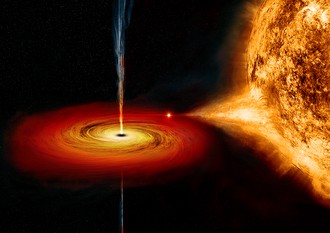
The recently discovered X-ray binary MAXI J1820 + 070, containing an accreting black hole (with a mass of 8.5 solar masses), is the subject of many studies and its activity attracts the eyes of X-ray telescopes. Many research groups use this source to study the appearance of accretion flow geometry in such systems and try to describe its changes over time.
Scientists from CAMK PAN in Warsaw Marta Dziełak and Andrzej Zdziarski in cooperation with Barbara De Marco from the Catalan University of Technology in Barcelona used an unusual technique that has so far been used only once to study such sources. They used a kind of tomographic approach, wanting to assess not only the appearance of the spectrum of the accretion disk and describe them with known physical phenomena, but also want to relate them to the distances from the accreting black hole.
By transforming the source's glow curves into power spectra, they were able to identify four areas of the disk that vary on different time scales. The timescales correspond to the distance of matter from the black hole (the shorter the timescales, the closer the matter is to the black hole). When the scientists observed that the lower energies under study were not variable on the shortest timescales (the area closest to the black hole), they created energy spectra for each of the disk's variable regions. It turned out that a simple image in which a cool accretion disk feeds photons to a homogeneous comptonization region (which is a hot plasma) is not sufficient to describe what they found in the studied source. The researchers managed to describe the accretion flow as a cool disk and two comptonization areas: the outer - powered by photons from the cool disk, and the inner - powered by photons leaving the outer comptonization area. In this way, scientists produced a consistent description of the lack of variation of low-energy photons in the inner regions of the accretion disk.
More in the original work "A spectrally stratified hot accretion flow in the hard state of MAXI J1820 + 070"
Pictured: Artistic vision of an X-ray binary system such as MAXI J1820 + 070. Source: NASA / CXC / M.Weiss






